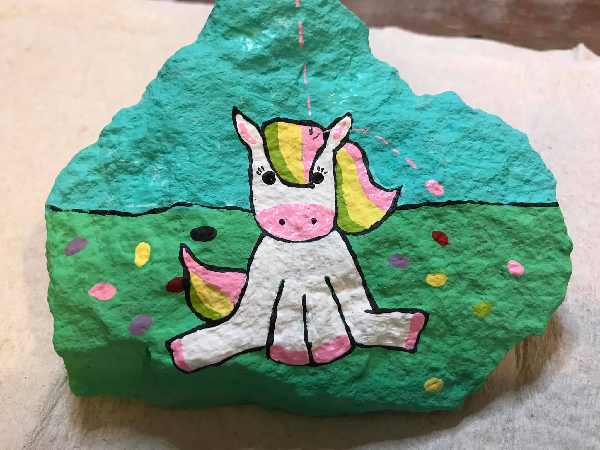Prior to the arrival of the Spanish in 1771, the Serrano and Paiute indigenous people of Southern California created outdoor parietal rock drawings called petroglyphs in an area of the southern Mojave Desert known as Victor Valley. This once-remote desert is where the cities of Apple Valley, Hesperia and Barstow are now located. Although the remaining ancient Serrano petroglyphs are mostly in locations far from Apple Valley’s residential sprawl, there is a group of contemporary rock painters working the new suburban landscape. And while the exact purpose of the ancient petroglyphs is unknown, there’s no question about these modern artists’ motivation. Calling themselves High Desert Rocks, this collective of artists doesn’t paint on stationary rock formations like the indigenous tribes once did; they prefer to paint small individual rocks, generally between two and five inches in length. The rocks are typically painted a solid color, then the obverse is scribed with a helpful maxim accompanied by a related image; the reverse side features the High Desert Rocks Facebook page address. Once finished, the artist searches for a proper place to leave the painted rock where it will be found, optimally by an individual in need of reassurance or comfort.

Rock painted by Rhonda Newman Walker, photo courtesy High Desert Rocks
The combination of the painted rock’s message of goodwill and its serendipitous delivery is powerful enough to most people that they post photographs of their find on High Desert Rocks. The Administrator of the FB page, Roxy West, who describes herself as an “art activist spreading kindness,” says that the artists “get a lot of gratification from someone finding their rocks.” Some, like Cecilia Rodriguez, feel that it’s okay if they “never see the smile on a stranger’s face or the painted rock ever again.” But one never knows: West tells the story of a homeless man who unintentionally crashed a rock painting party and to everyone’s amazement, pulled out three treasured painted rocks from a small velvet Crown Royal Whiskey pouch. Rodriguez is so proactive about people finding stones that she helps out at “fairy gardens,” places where rocks are left en masse for those unfortunate enough not to find one at random. This kind of psychic gratuity is a good example of how the missionary zeal of High Desert Rocks painters is powered by a relentless positivism.

Photo by Roxy West
Like all art forms, rock painting isn’t confined to one purpose or type of imagery. Although many High Desert Rocks painters favor feel-good iconography such as Snoopy or elfin toadstool houses, there are others like Lindsey Germain, who prefer “creepy, comic and sci-fi stuff.” And, like all artists, she has her critics, “I can’t hide some stones because I know someone would complain about it. LOL” Such internecine conflict may be unexpected, but it’s not surprising considering that the point of all this activity is to improve other people’s lives through sentimentality.

Rock painted by Lindsey Germaine, photo courtesy High Desert Rocks
July 3rd, International Drop a Rock Day, is touted as a global opportunity for rock painters to become “kindness ninjas.” But even with such an international base, the Fine Art World considers rock painting, if it considers it at all, with a characteristic elitist contempt. And that’s a shame, because with a refreshing sincerity reflecting its rural sources and isolation from High Culture, rock painting evidences all the hallmarks of legitimate Folk Art; as West says, this art “is purely from the heart and doesn’t need recognition or validation.” In fact, one could say that these rock painters are literally returning to the roots of desert culture. Although there isn’t a direct link between High Desert Rocks and the ancient petroglyph paintings of the Serrano and Paiute Indians, there is a kinship based on successful artistic communication between remote individuals. Which is great, because what the world needs now is art that exists for a purpose other than the justification of its own existence.

Photo by David Stillman

